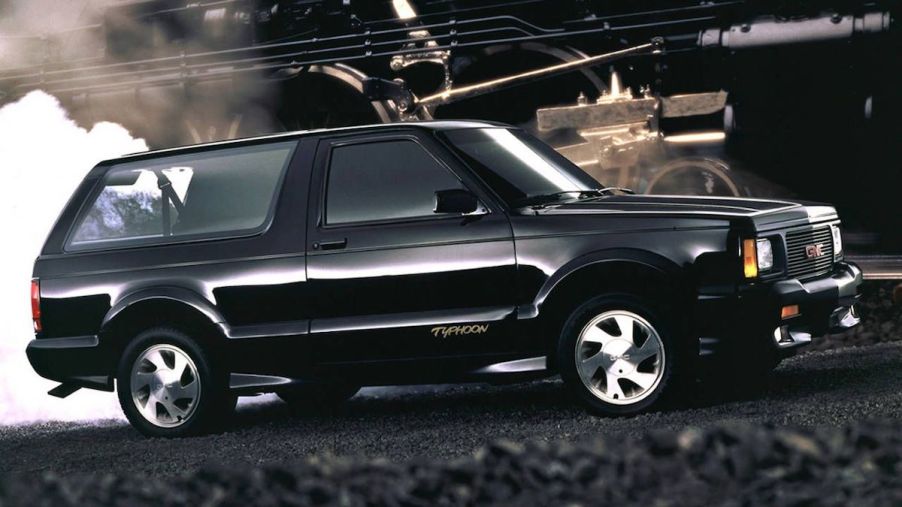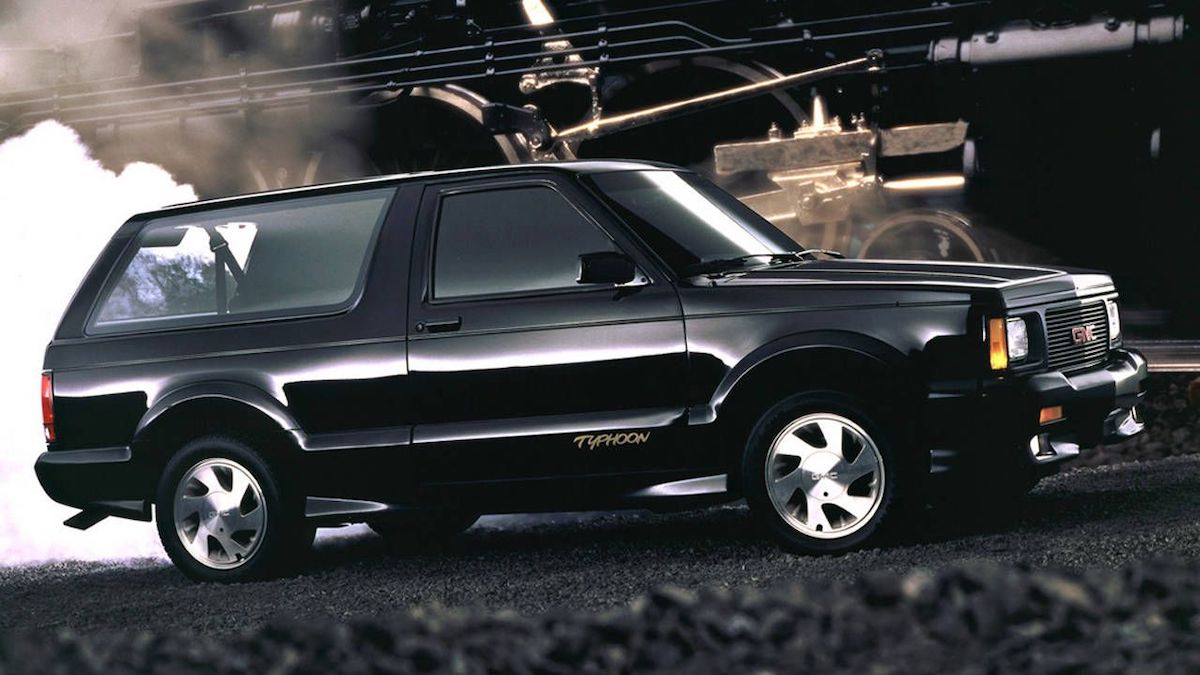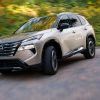
How Fast and Powerful Was the GMC Typhoon?
The Typhoon SUV followed the Syclone pickup truck in GMC’s arsenal of large performance models. Starting with the smaller Jimmy, which shared the same platform as the Sonoma/Syclone, GMC went to work transforming the SUV into a high-performance vehicle. You’d think that as the sequel to the Syclone, the Typhoon would be faster and more powerful, but that wasn’t the case. It had the same engine as the Syclone, with the same power output. As an SUV, the Typhoon was also slightly heavier than the Syclone, hindering performance.
So, how fast and powerful was the GMC Typhoon?
The GMC Typhoon helped pioneer the performance SUV

By the mid-’80s, horsepower and performance were finally rising above their nadir in the “malaise era” of the ’70s, when emissions controls choked engines, limiting horsepower and hurting reliability. Fuel injection and electronic engine control led automakers out of the dark ages. By 1985, the Chevrolet Corvette’s small-block V8 produced 230 hp, and turbocharged engines like the one in the Buick Grand National topped 200 hp.
At the same time, small SUVs were becoming popular thanks to the Jeep Cherokee’s arrival. Ford responded with the Bronco II, and General Motors produced the Chevy S10 Blazer and the small GMC Jimmy. Hoping to capitalize on the dual trends of performance and SUV popularity, GMC looked to add horsepower to its lineup. Dropping the 5.7-liter V8 into the Sonoma and Jimmy proved impractical, but both vehicles could already accommodate GM’s line of V6 engines, leading GMC to take a page from Buick’s Grand National playbook.
Starting with the 4.3-liter V6, GMC strengthened the block and added turbocharging. It developed an all-wheel-drive system for traction and performance. Then GMC’s engineers bolted everything into the Sonoma, followed by the Jimmy, leading to the birth of the Syclone and the Typhoon.
The result was a pair of trucks that could take on not only the muscle cars of the era but also sports cars from Ferrari and Porsche. Unfortunately, the idea of the muscle truck didn’t catch on. GMC sold about 3,000 Syclones and 4,700 Typhoons in three years.
Typhoon specs and performance
The GMC Typhoon was a small two-door SUV based on the GMC Jimmy. Produced from 1991 to 1993, it packed a 280-hp 4.3-liter turbocharged V6 engine and all-wheel drive. It sat on a lowered suspension and used an antilock braking system (ABS). Thanks to the lower ride height and more aggressive front air dam, side skirts, and wheels, it looked like a sportier Jimmy.
The Typhoon could carry up to five people and haul about 500 pounds of cargo, but it was really meant to haul ass. Car and Driver tested the Typhoon, recording a 5.3-second 0-to-60-mph time and a quarter-mile run of 14.1 seconds at 95 mph. Performance tires and ABS stopped it at just 185 feet from 70 mph. Even more impressive, the Typhoon handled well. With 0.79 g of cornering grip, it could blow away muscle cars on the straights and stick with the sports cars in the corners.
To say it shocked the sports car world is an understatement. But it also stunned buyers with its sticker price. Starting at $29,530 (about $57,000 today), it cost $5,000 more than a Pontiac Trans Am and almost as much as a Corvette.
The GMC Typhoon was fast, but the Syclone was faster
The Typhoon offered impressive performance, but the Syclone was quicker. They shared the same engine and performance specs, but the Typhoon was about 220 pounds heavier, weighing 3,822 to the Syclone’s 3,599.
As a result, where the Typhoon could sprint to 60 in 5.3 seconds, the Syclone did it in 4.3. The Typhoon was about a half-second slower in the quarter-mile, taking 14.1 seconds to the Syclone’s 13.7.
Still, the Typhoon was an impressive achievement and one of the first performance SUVs. A decade after production ended, Porsche introduced the Cayenne, calling it the “Porsche of SUVs.” But while the Cayenne can boast the Porsche badge, the performance S Turbo model Car and Driver tested was slower to 60 mph, taking 5.5 seconds to the Typhoon’s 5.3.



